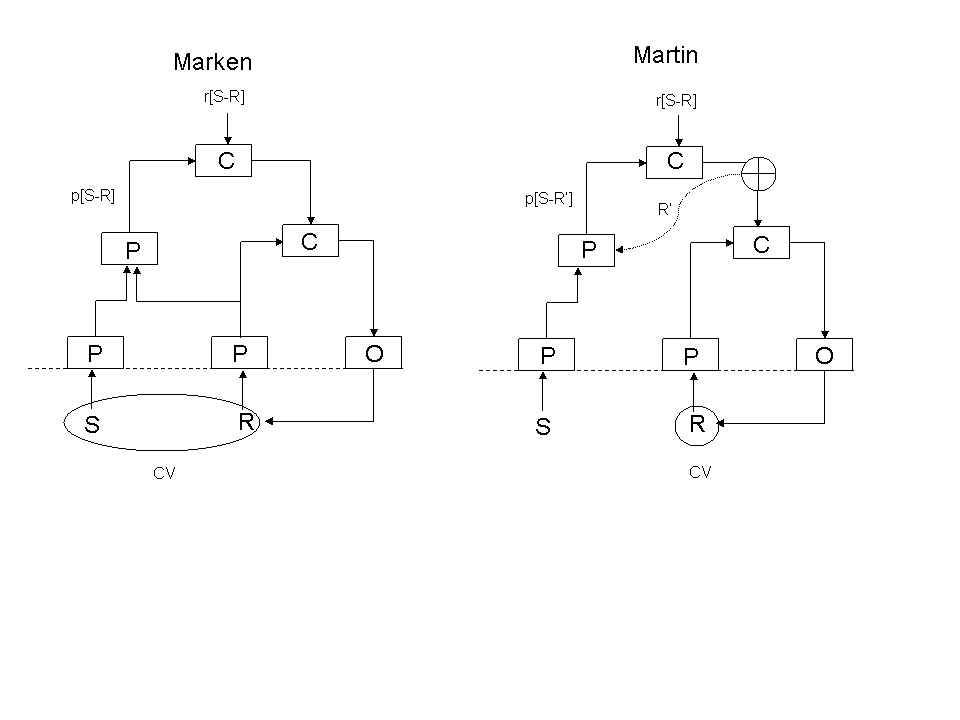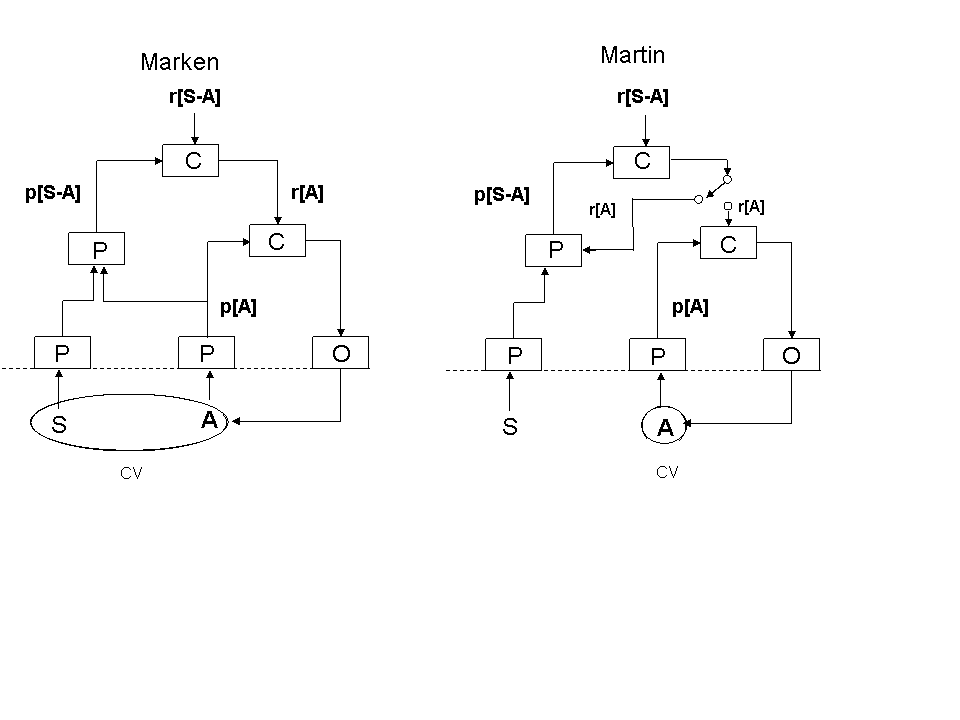[Martin Taylor 2010.08.06.23.09]
[From Rick Marken (2010.08.06.1630)]
Martin Taylor
(2010.08.06.17.01) –
Rick Marken (2010.08.06.1230)]
RM: So let me know if this current iteration is on
the right track.
MT: I do have some quibbles with the labelling, which are
the same as what I mentioned earlier.
RM: Yes, I like your changes to the names of the perceptual
signals. I don’t really understand why you want to call the
imagined response signal “A” and the perceived response
signal “p[R]”.
Because A and R are of completely different character, as I have
pointed out over and over again. You keep wanting to call them the
same thing, because in your model they are. In my model they are
not. If you wanted to draw a complete circuit diagram for the model,
you would have a lot more output stages between A and R than the
single one shown in both our models. Just as in a tracking
experiment where the conventional diagram shows just a simple line
between the output of the control system controlling
p(Cursor-Target), instead of a whole complex of control systems to
the top of which the C-T control system sends a reference signal, so
in our models we make one simple control loop take the place of many
whose end result is to produce R.
After all, what you call "A" is functionally just the
reference signal for p[R], but with the imagination “switch”
thrown so that this signal directly enters the perceptual
function that perceives the relationship between the stimulus
and response (as perceived).
Not quite. A is a variable but r[R] is its value at some moment --
usually the moment when the p[p[S] - A] control system has arrived
at zero error.
I also don't agree with calling p[p[S]-A] a controlled
variable.
Of course it is a controlled variable. Just as with any control
system, the output signal influences the perceptual signal, and
changes its value to approach its reference value. What’s not a
controlled variable about that?
Bill addressed this in his comments earlier. A controlled
variable (in PCT) has an environmental correlate, the
controlled quantity, which can be detected by an experimenter.
The controlled quantity is ALWAYS a perception, never an
environmental variable. That’s PCT 101, first lesson. And as Bill
corrected me in the partner thread, the output of a control unit
knows or cares nothing about where its signal goes. Control exists
if the output influences the perception. If the influence of the
output reaches the perception through the external environment, so
be it. If the influence of the output reaches the perception by way
of an internal connection we call imagination, so be it. If the
influence of the output reaches the perception both through the
external environment and through internal pathways, so be it. Any
which way, it’s irrelevant to the control unit. Control through an
internal feedback pathway is likely to be orders of magnitude
faster, than through a pathway through the external environment, and
that might affect the stability of the control unit, but otherwise,
it’s irrelevant.
The way you use "(in PCT)" strongly suggests that "PCT" is what some
authority says it is, like a religion, rather than what analysis and
experiment discover it to be, like a science. I don’t go along with
that. And in any case, I reiterate my reminder to you that it is
“PERCEPTUAL Control Theory”, not “Environmental Variable Control
Theory”.
There is no environmental correlate of p[pS]-A] (because A
exists only in the subject’s imagination) so it’s really not a
controlled variable.
The part before "so..." is true; the part after "...so" is not.
MT: I don't care how
you label in your model, but I do want the overt response
variable in my model to have a DIFFERENT label from the
answer variable.
I think it's important to give the same variables in the two
models the same names. I believe the variable labeled “A” in
the diagram my model is precisely the same as the variable you
label “R” in your diagram of yours: they are both the answer
that the subject is observed to make in the experiment.
That's correct, but I didn't redraw your model or revise its
labelling, since the model is yours. I’d like it better if you used
the label R in your model, because your model really doesn’t have
anything equivalent to my variable A.
But I don't want to argue about variable names. If you accept
the two diagrams are being reasonable descriptions of the
architecture of our two models then I think the next step is
to implement them as working models of a detection
experiment. I would recommend starting with a simple yes/no
detection task rather than a forced choice task.
I can't see a problem with that. The controlled variable, and
possibly its level in the perceptual hierarchy, might be different,
but that shouldn’t affect the question at hand.
Having modelled it, what do you do then to discriminate between the
models?
I can't think of a way to model an N alternative forced
choice detection task without having N control systems like
the ones shown in our models, with some mutual inhibition
between them for when more than one system detects a tone. I
could get complex fast.
I don't think it's as complex as you suggest. I think the difference
should be handled in the perceptual system, in the part represented
by the p[S] box in our diagrams. In an N-AFC experiment, the p[S]
function has to have at least two stages. The first provides some
index of the likelihood that each interval in turn contains a
signal, and the second is a sequence-level perception. Sequences
“High Low Low Low” and “Low Low High Low” are different, so either
my “A” would need to be an imagined sequence or there would need to
be a third perceptual stage in which the sequences were translated
into category perceptions “First” or “Second” or… “Nth” and the
relationship control done at the category level. I rather prefer
this second possibility, but I don’t know how one could distinguish
them experimentally.
Remember from your psychophysicist days that in an N-alternative
forced choice experiment, the subject quite often would not have
said “Yes” to the signal having been in any one of the alternatives,
had it been presented alone. What the subject does is to compare the
intervals, and assess which interval is most likely to have
contained the signal, knowing that at least one interval did.
[Aside: very early in my career we did some 2AUC experiments (2
alternative unforced choice) in which the subject was not required
to choose if she was unhappy with making a choice. We made up and
published tables of d’ especially for this case. I don’t remember
the results as being very different from the forced-choice
experiment, but it was a long time ago.]
I suggest that we model an experiment where on each trial
there is a burst of noise that does or does not contain a
tone. The subject’s task is to say “yes” if a tone is present
and “no” otherwise. I think both of our models could be
applied to this task quite easily.
Yes, but what is the experiment that distinguishes between the
models? What data would be collected, and what characteristics of
the data would favour one model over the other?
Martin



